Abstract
1. A method is described for isolation of the aortic arch and right subclavian—carotid angle in situ in the rabbit and perfusion with Krebs—Henseleit solution or blood under controlled conditions of pressure and temperature.
2. The characteristics of the baroreceptors of the aortic arch and right subclavian—carotid angle were studied by recording from single or few-fibre preparations of the left and right aortic nerves respectively. Curbes were plotted to show the relationship between the frequency of baroreceptor impulse activity and intra-aortic pressure during non-pulsatile perfusion under steady-state conditions.
3. The aortic arch and right subclavian—carotid angle baroreceptors were found to have similar characteristics. Three types of response of the baroreceptors at the threshold pressure to a steady intra-aortic pressure are described.
4. Increasing the intra-aortic pressure increased the frequency of impulses in fibres previously active and caused recruitment of other fibres in multi-fibre preparations. The relationship was linear at low pressures and a point of inflexion occurred at higher pressures in the majority of fibres.
5. Lowering the temperature of the perfusate reduced the impulse frequency at any given pressure.
6. The curves obtained during stepwise increases and decreases in intra-aortic arch pressure were dissimilar, particularly at the lower end of the pressure range. This phenomenon is probably due to properties of the arterial wall.
7. When the aortic arch preparation was excised, changes occurred in the shape of the impulse frequency—pressure curves from baroreceptors in both areas. The point of inflexion was elevated and a higher percentage of fibres failed to reach a point of inflexion in the pressure range studied.
Full text
PDF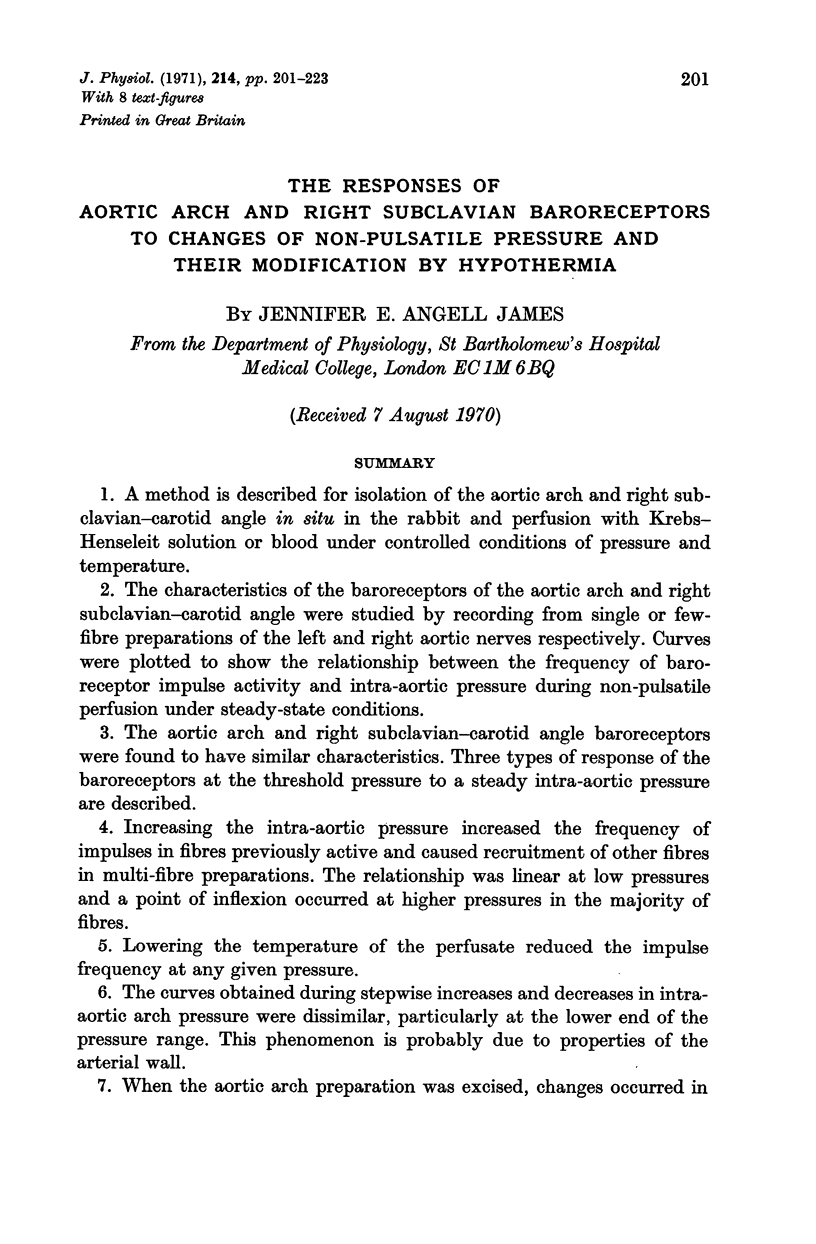
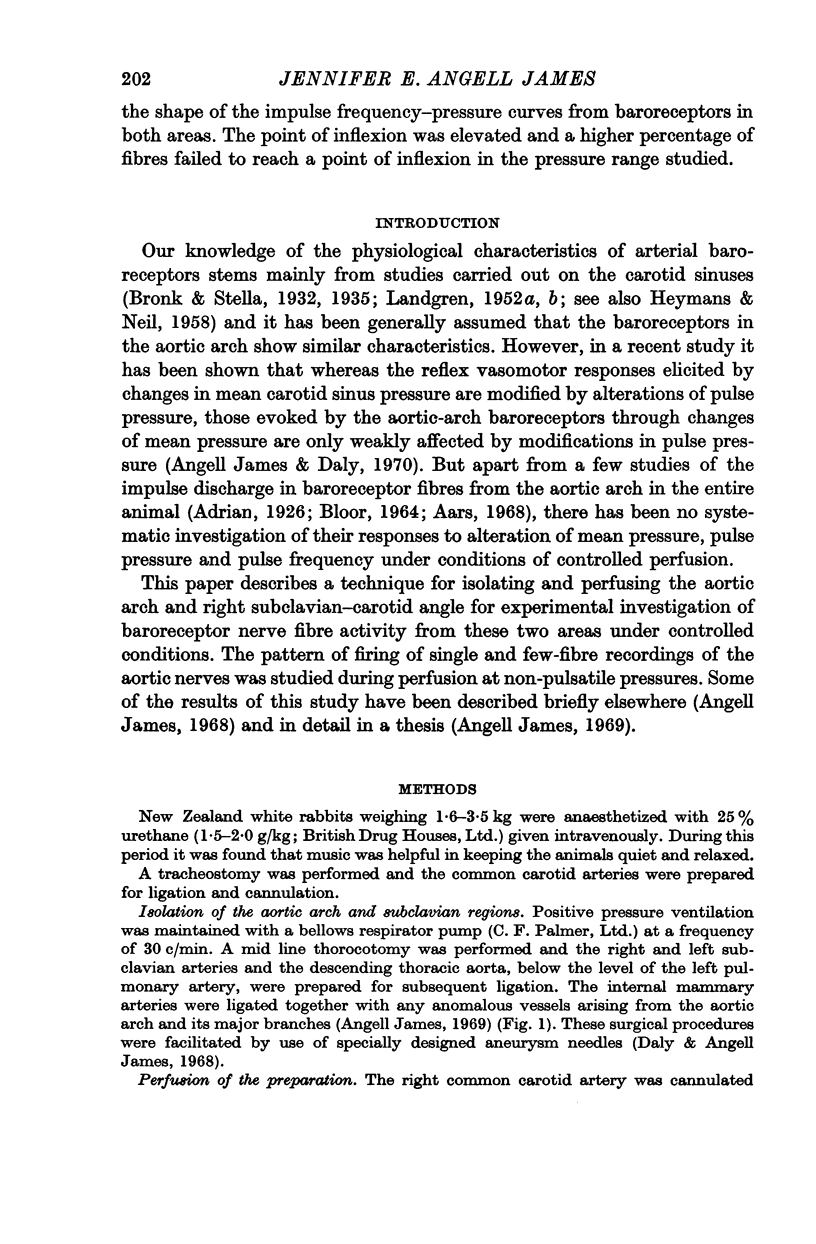
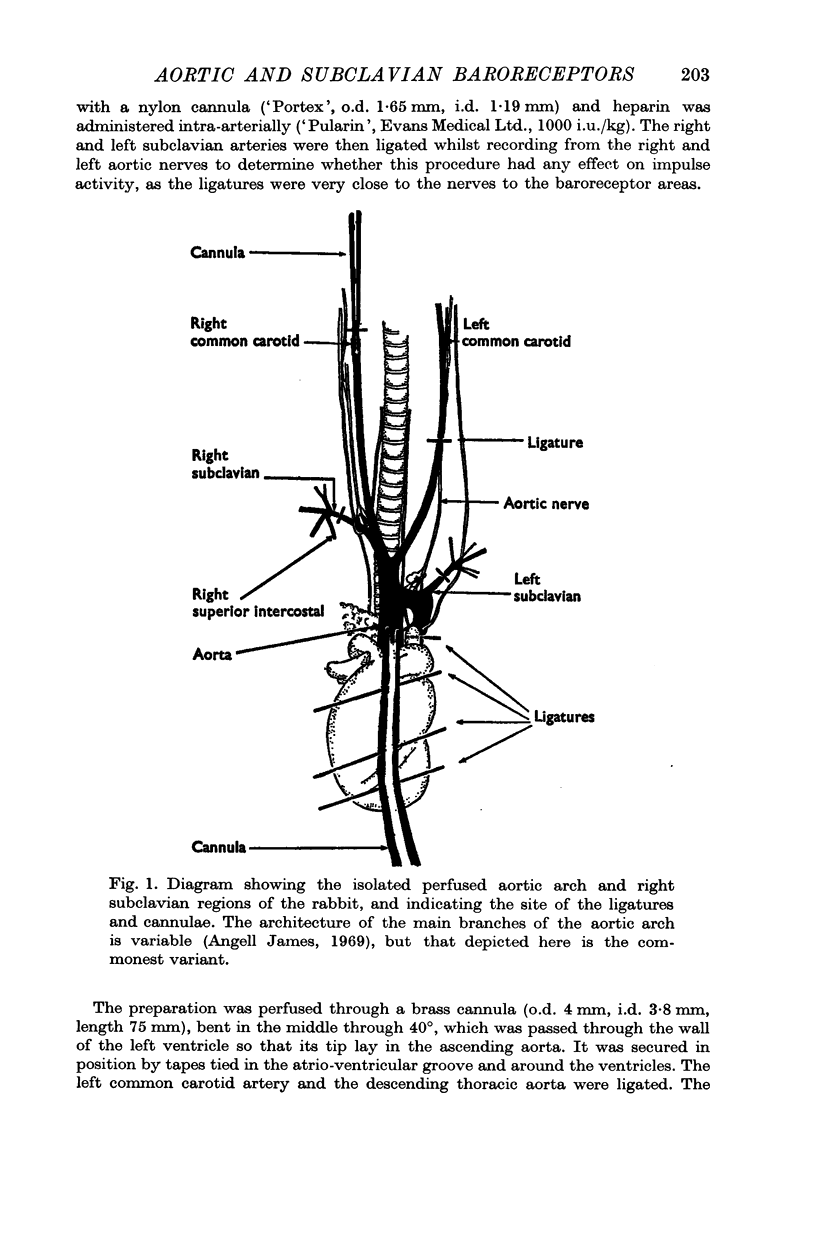
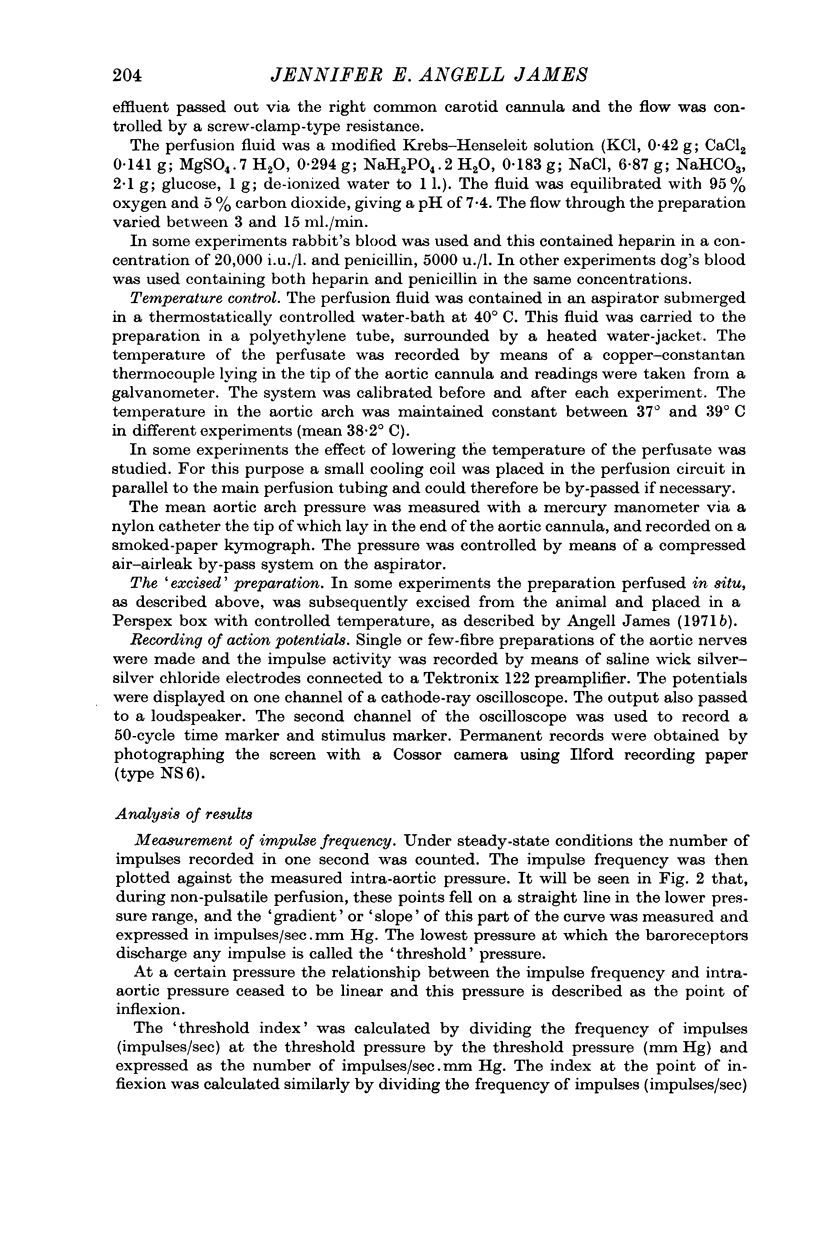
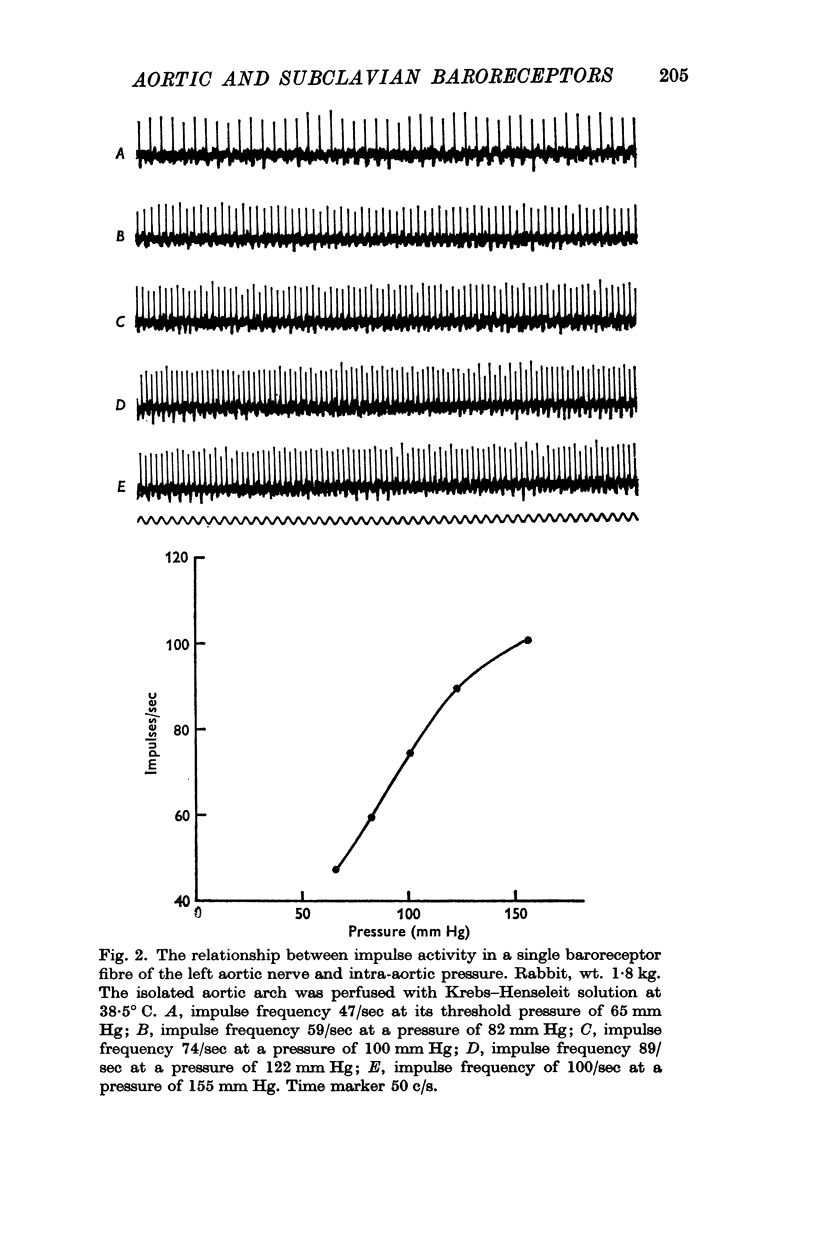
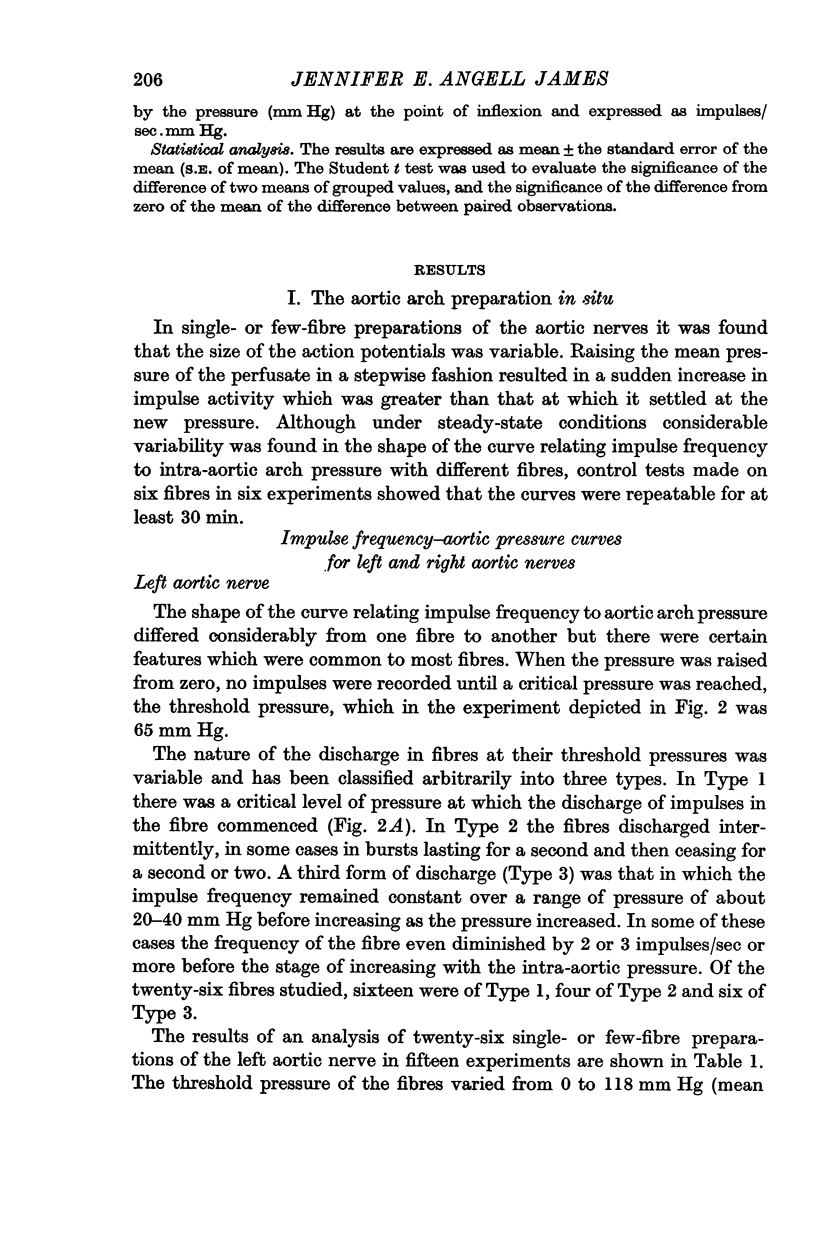
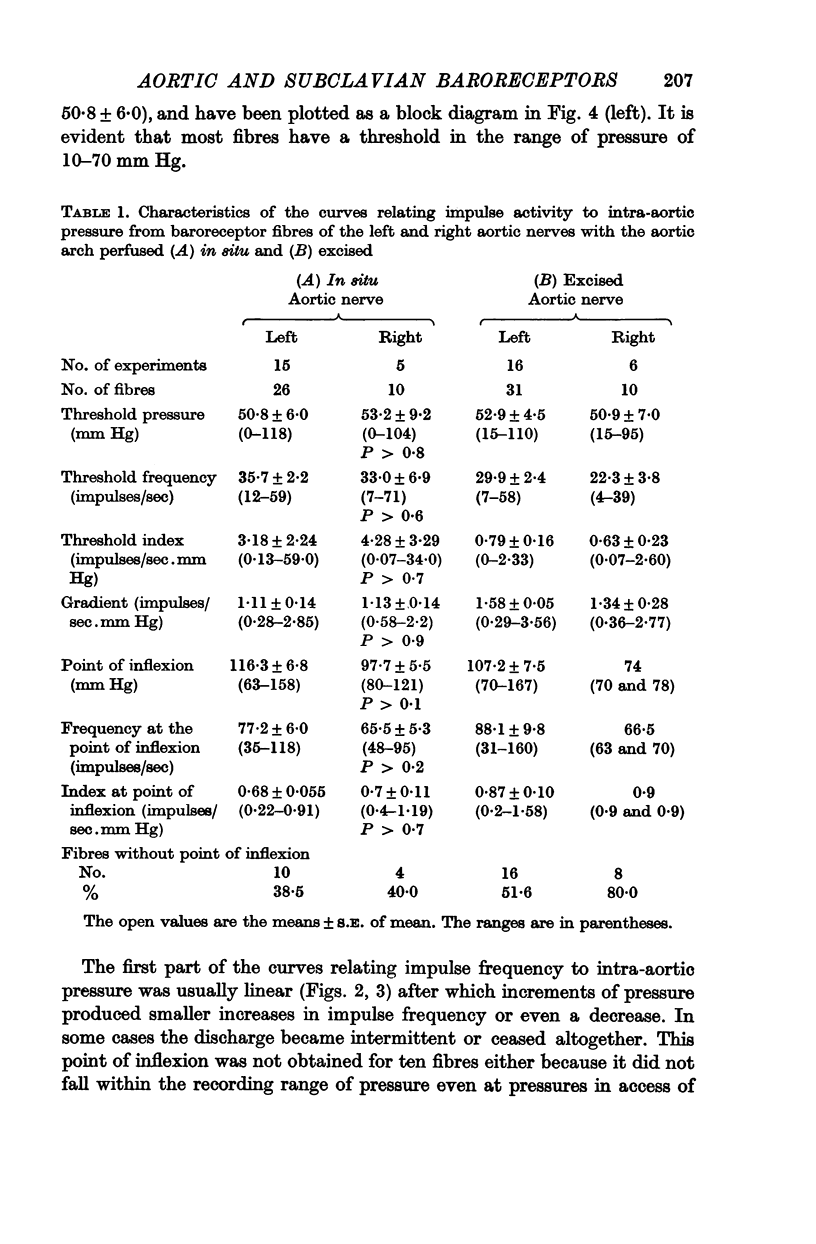
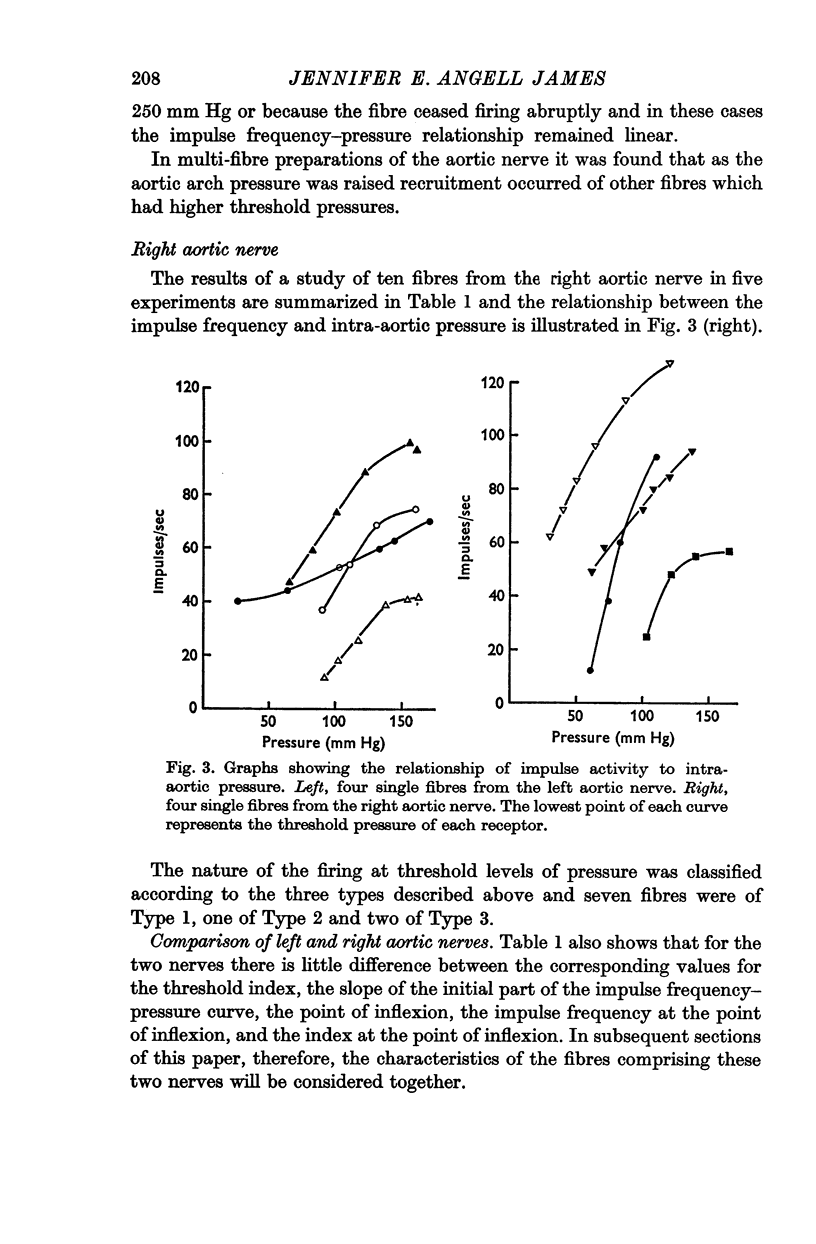
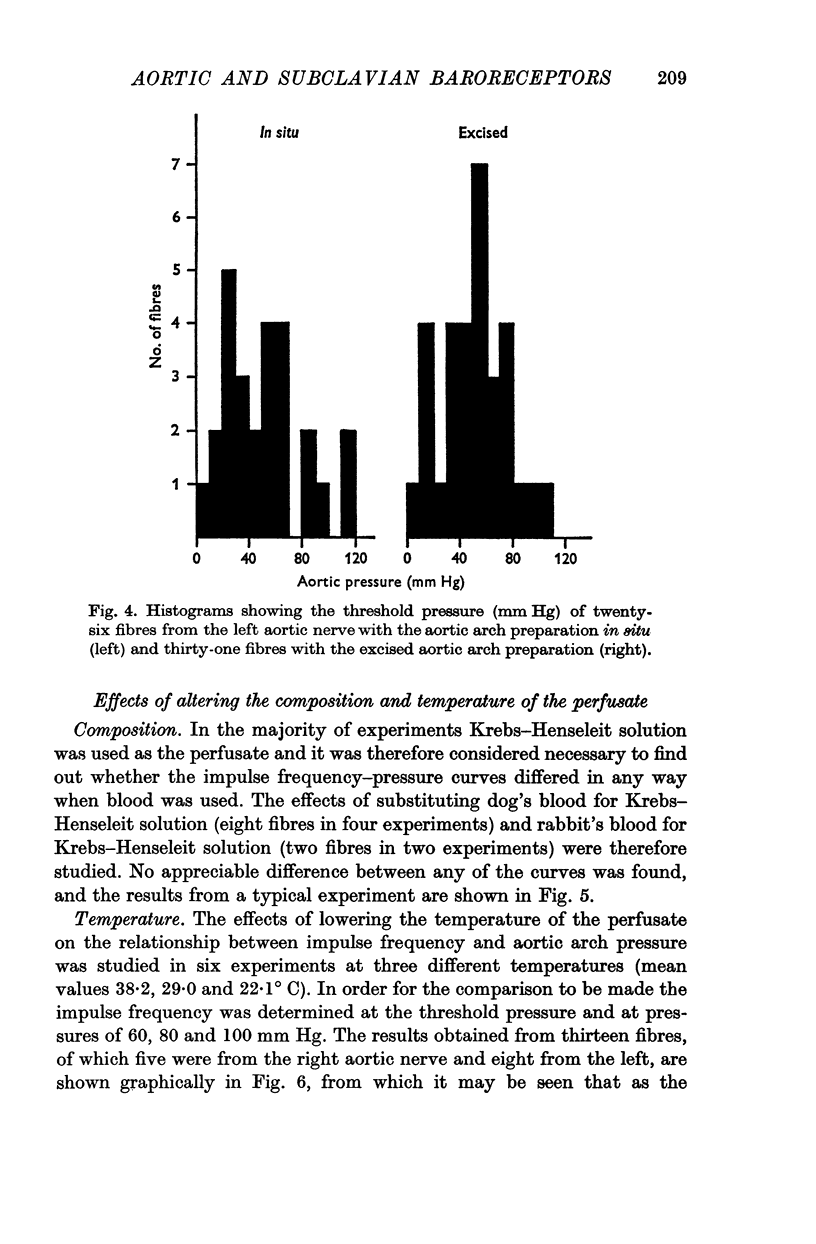
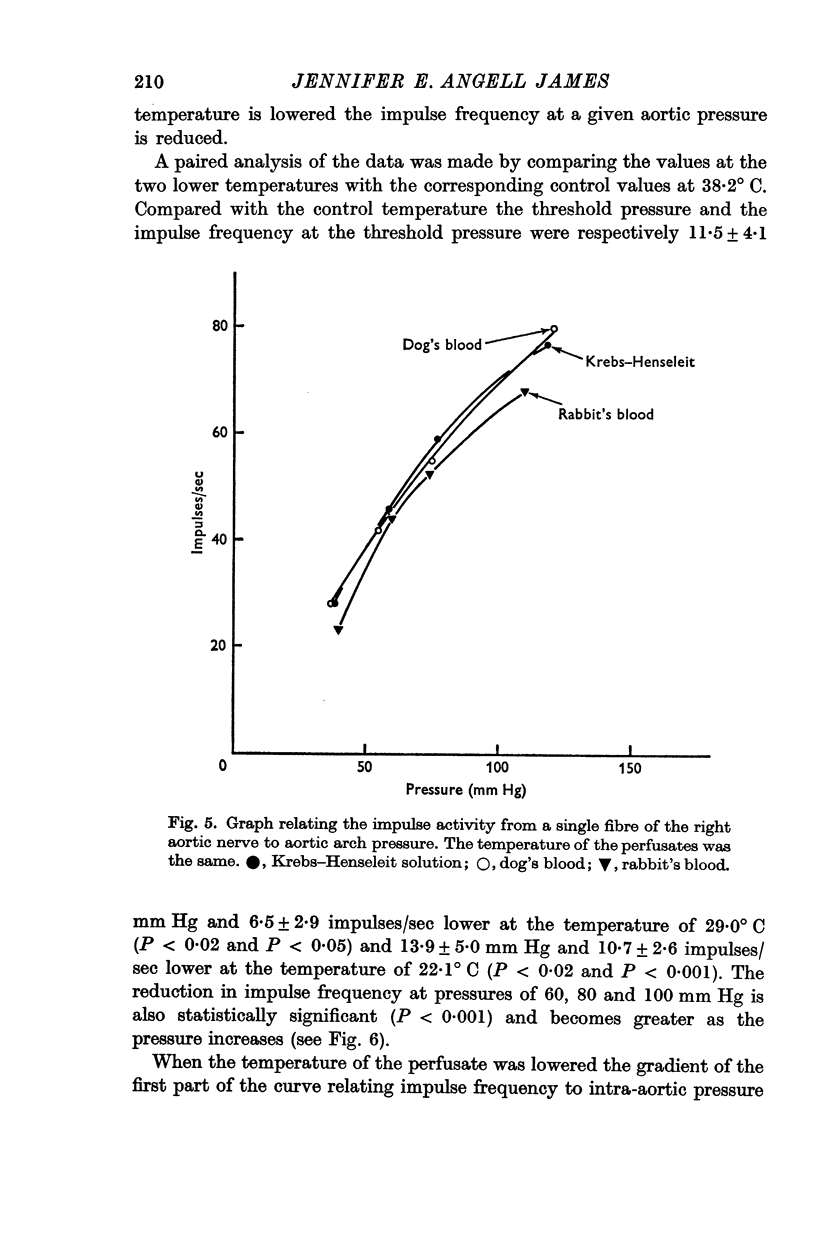
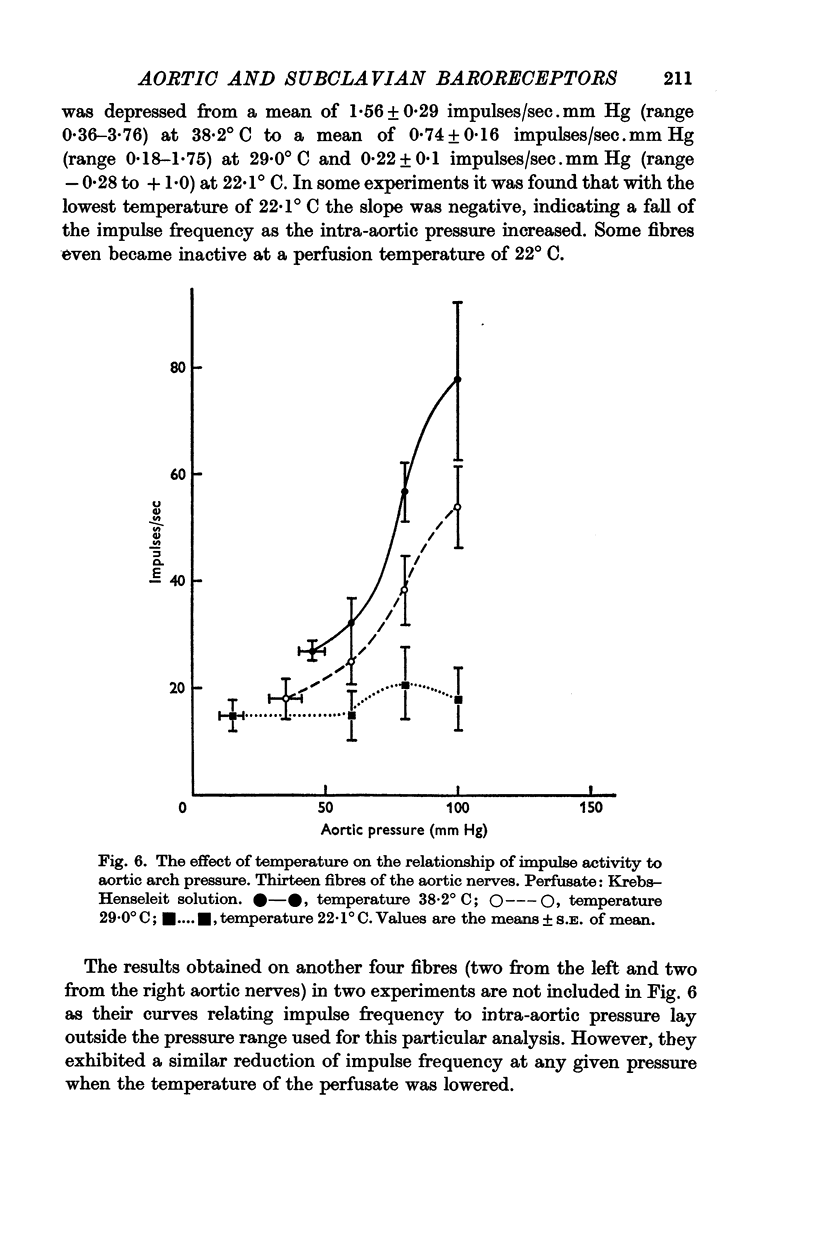
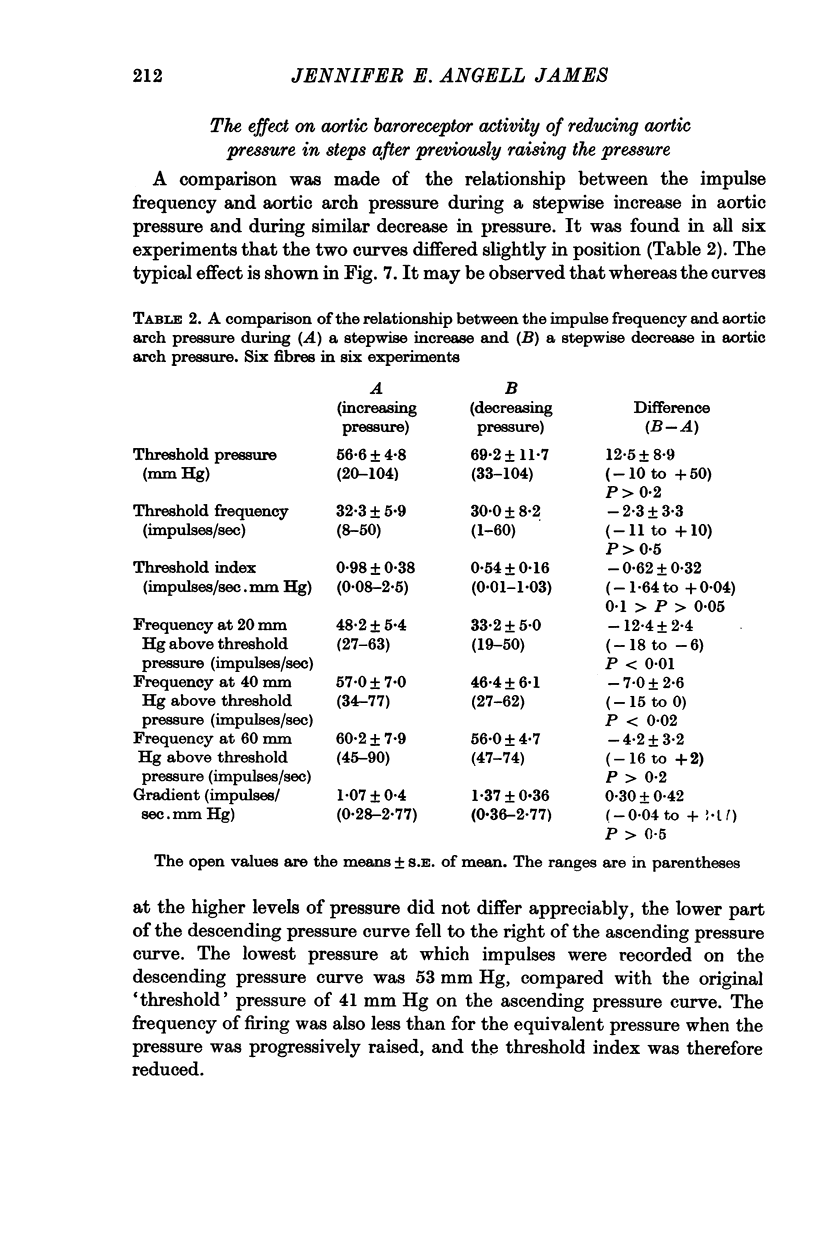
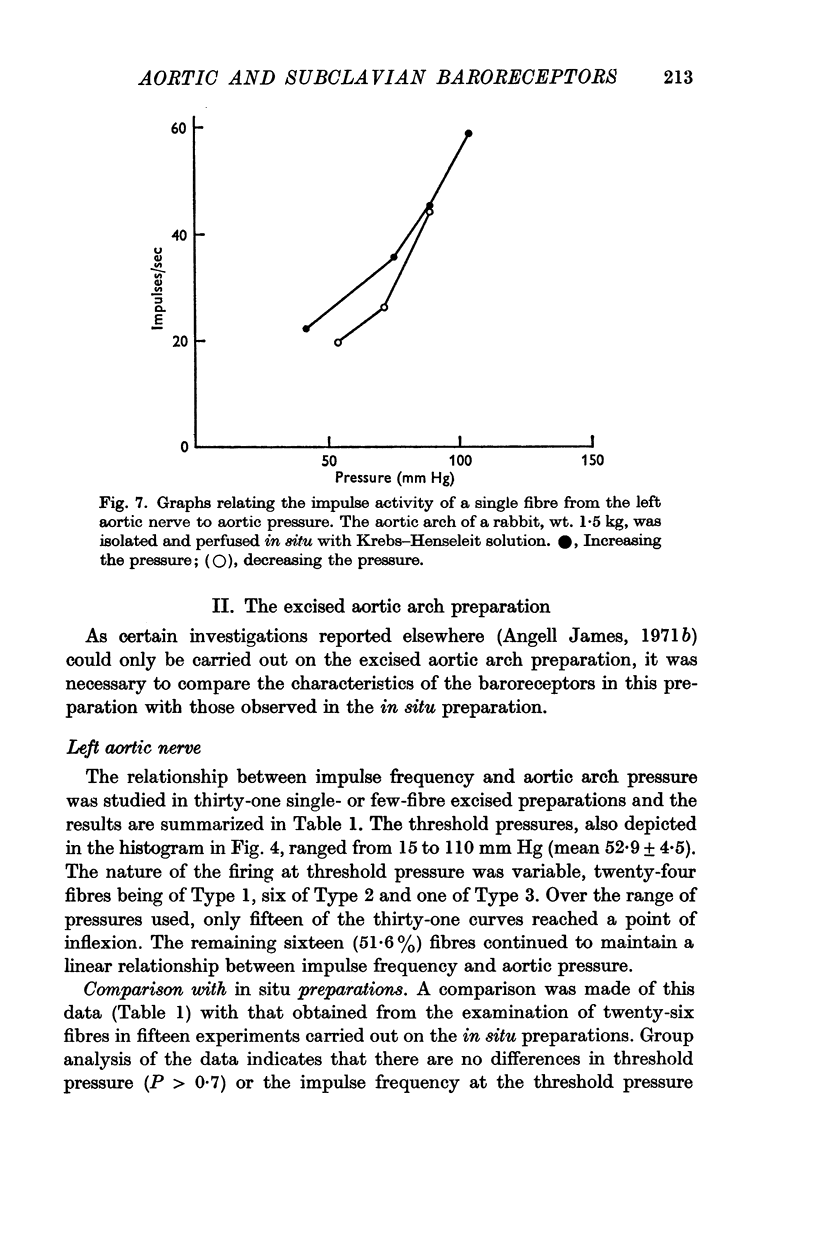
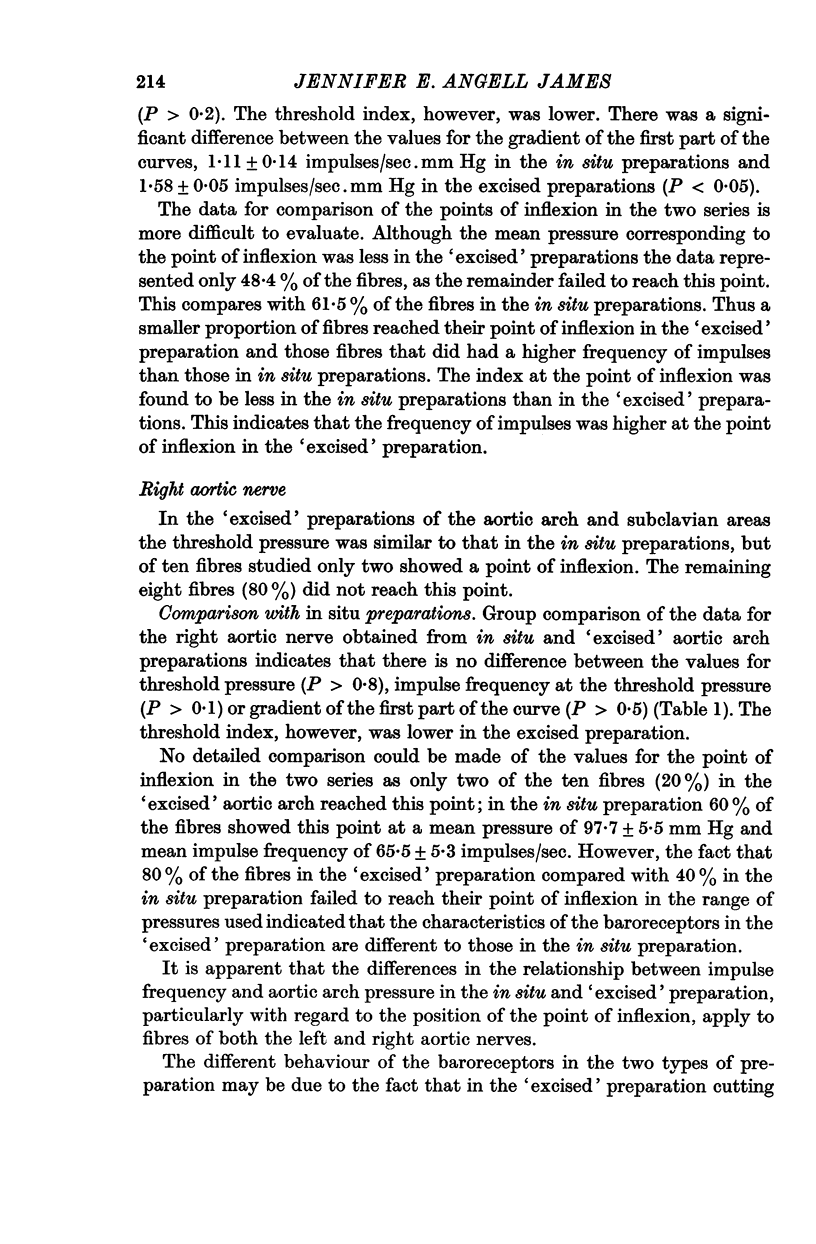
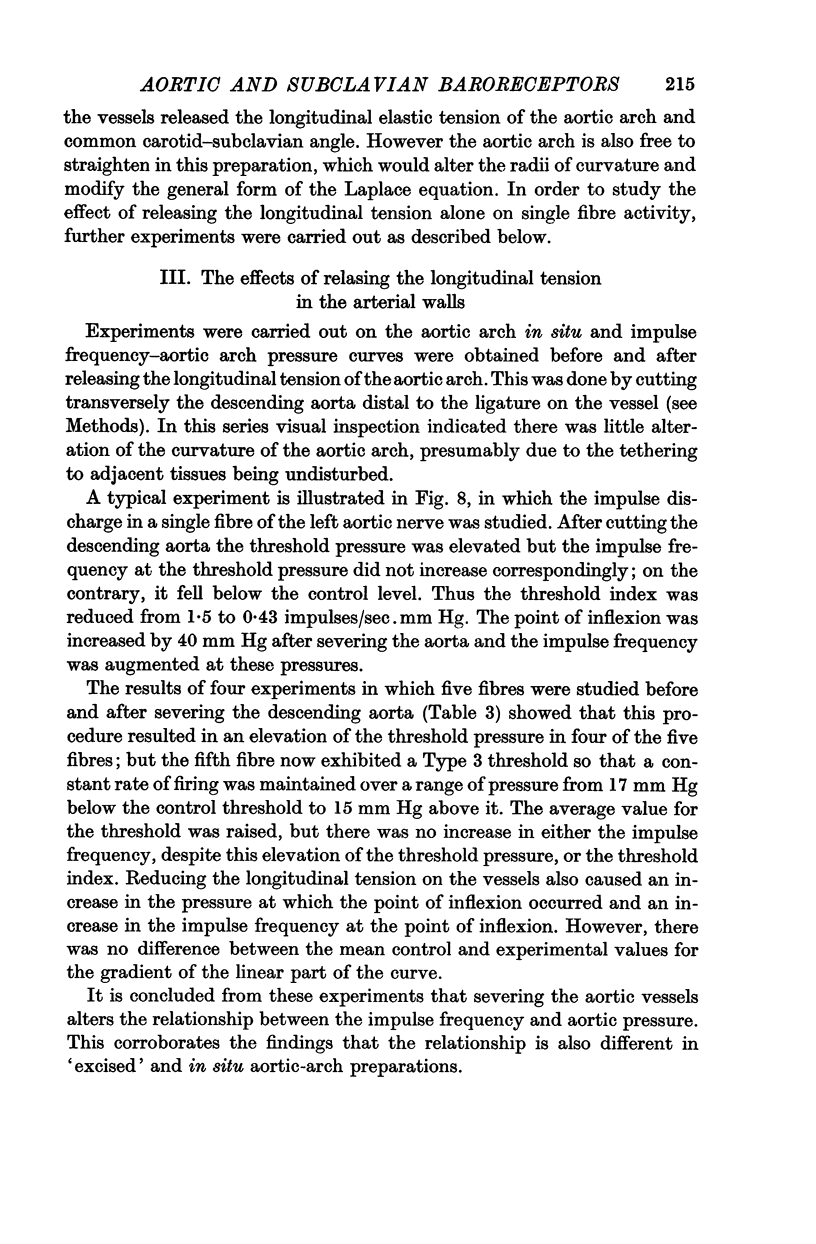
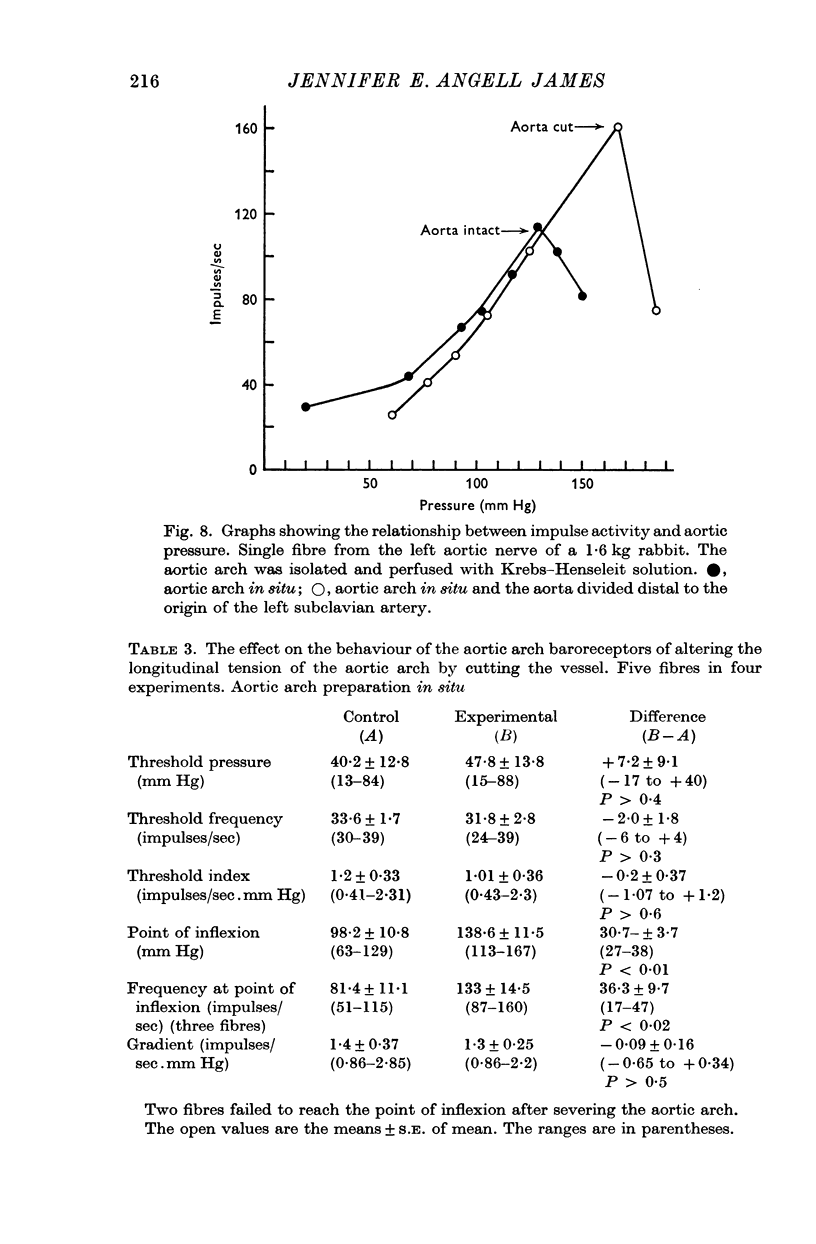
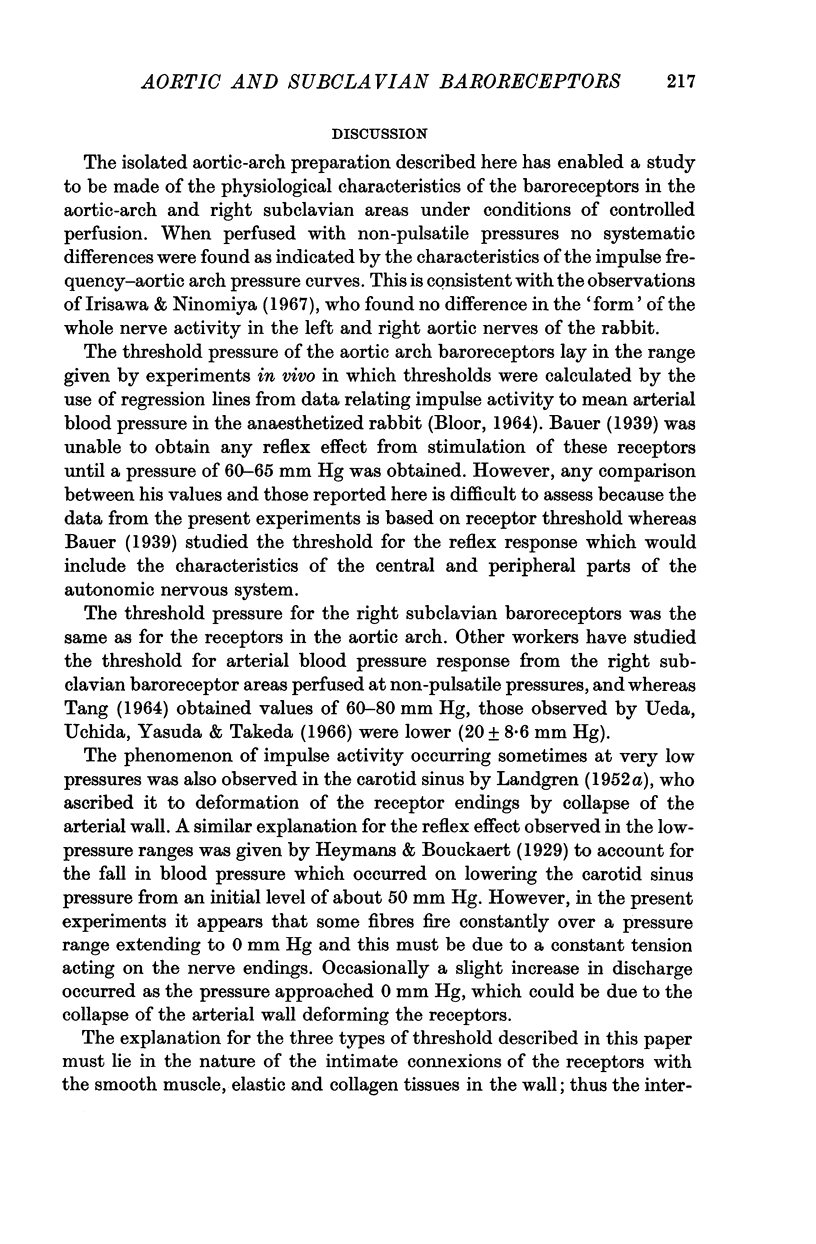
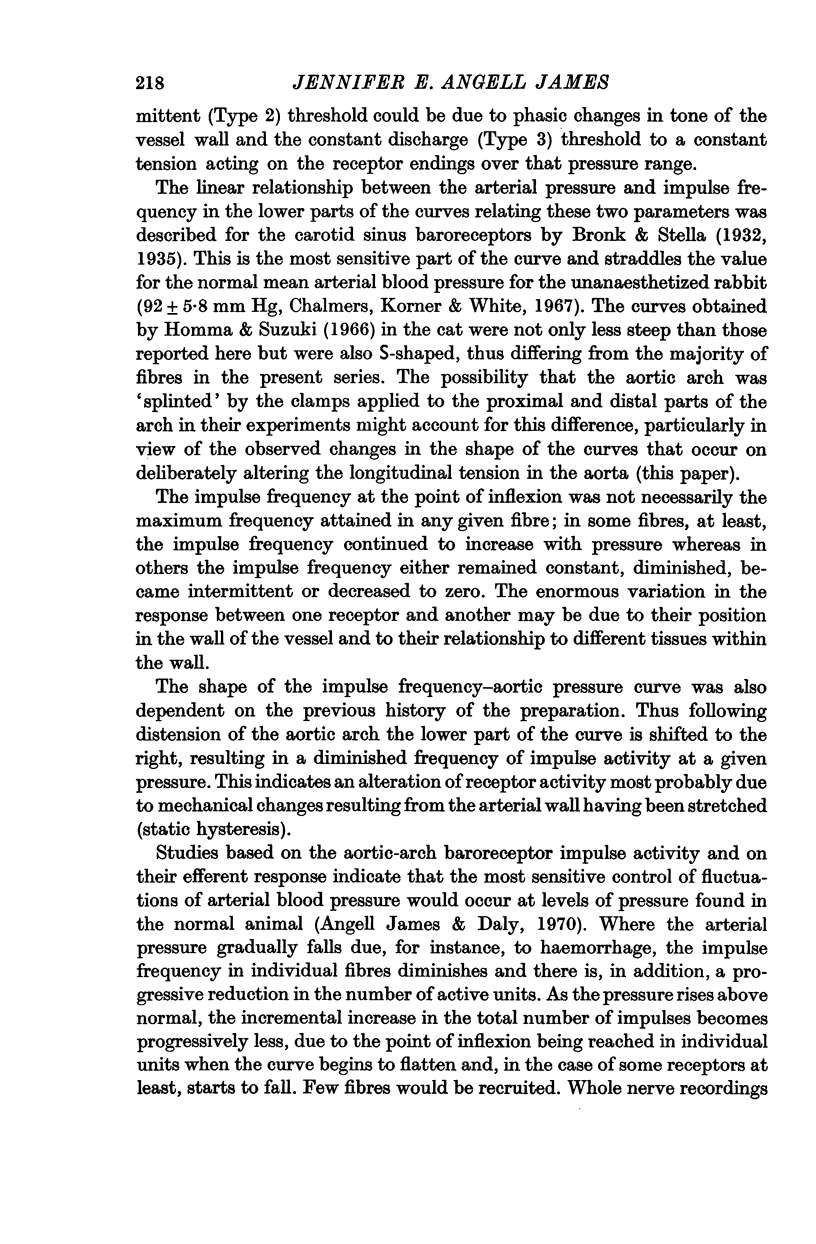
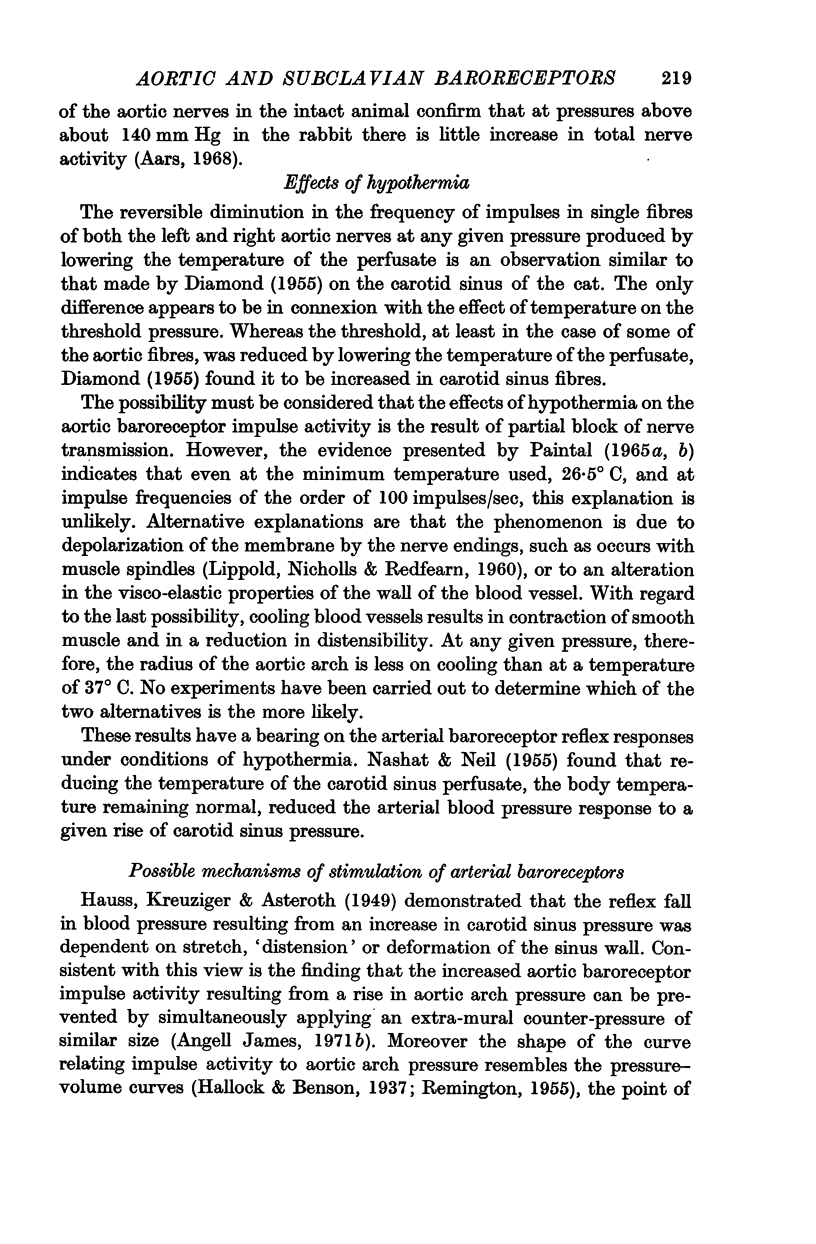
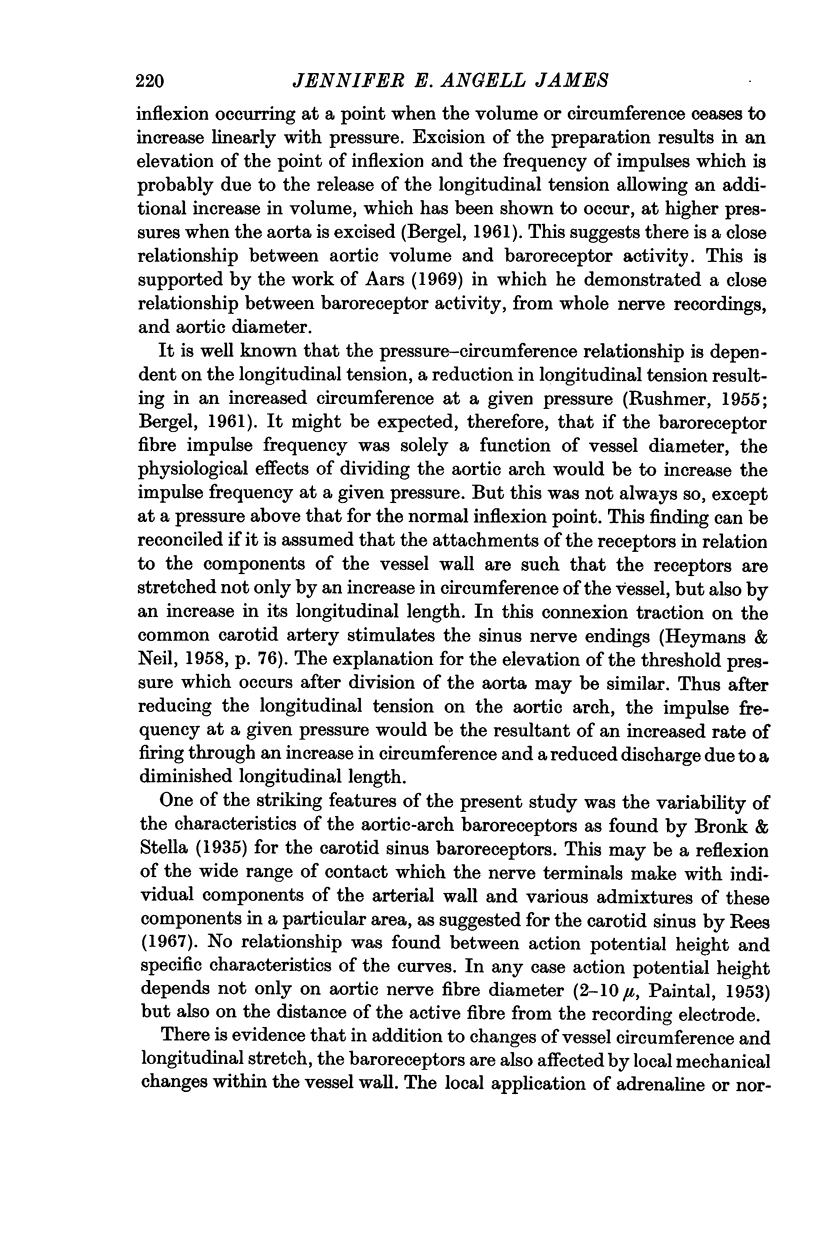
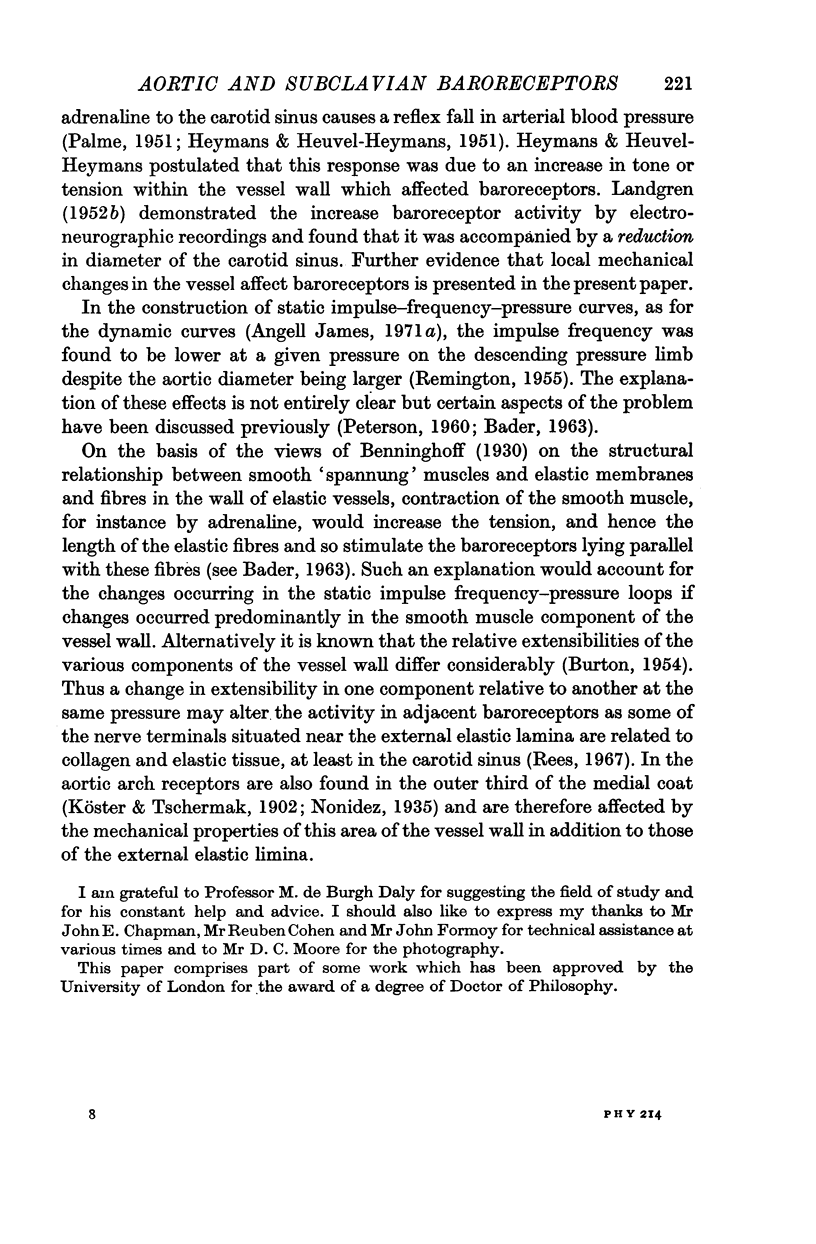
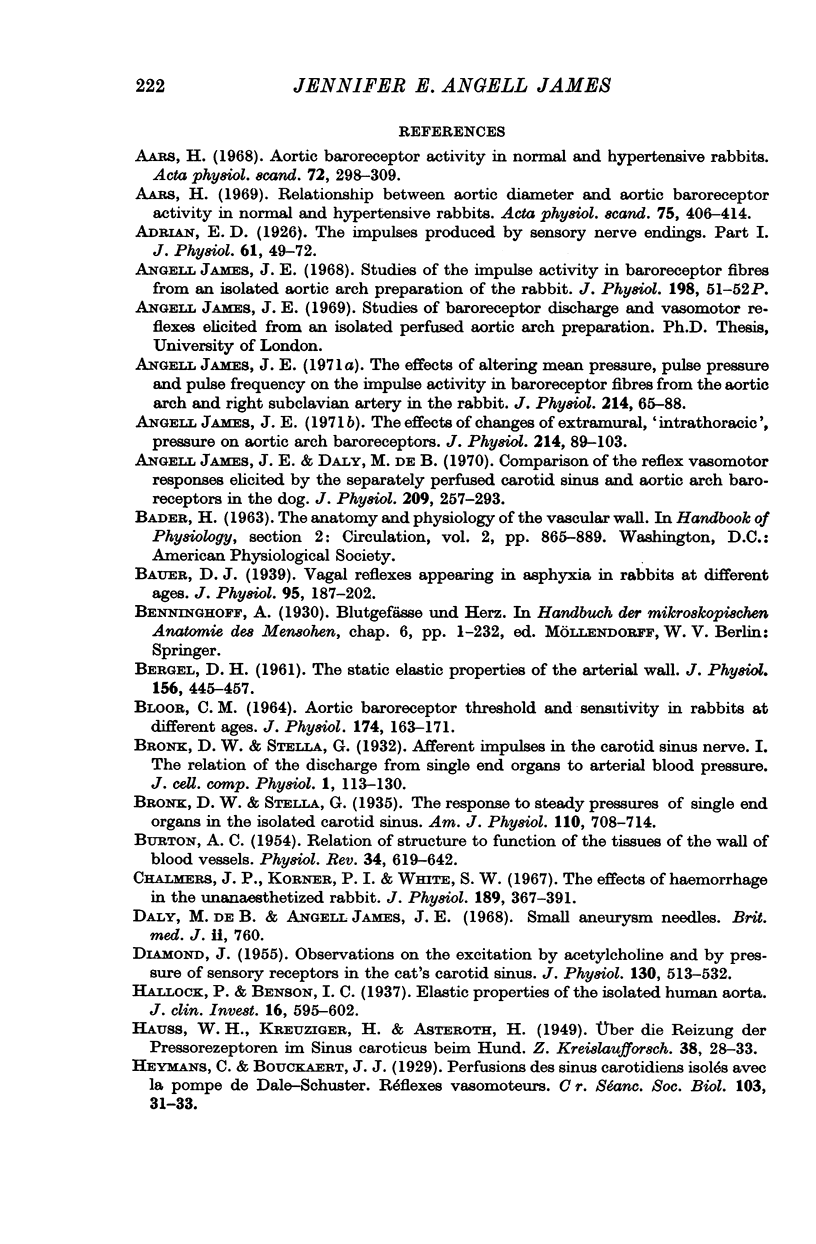
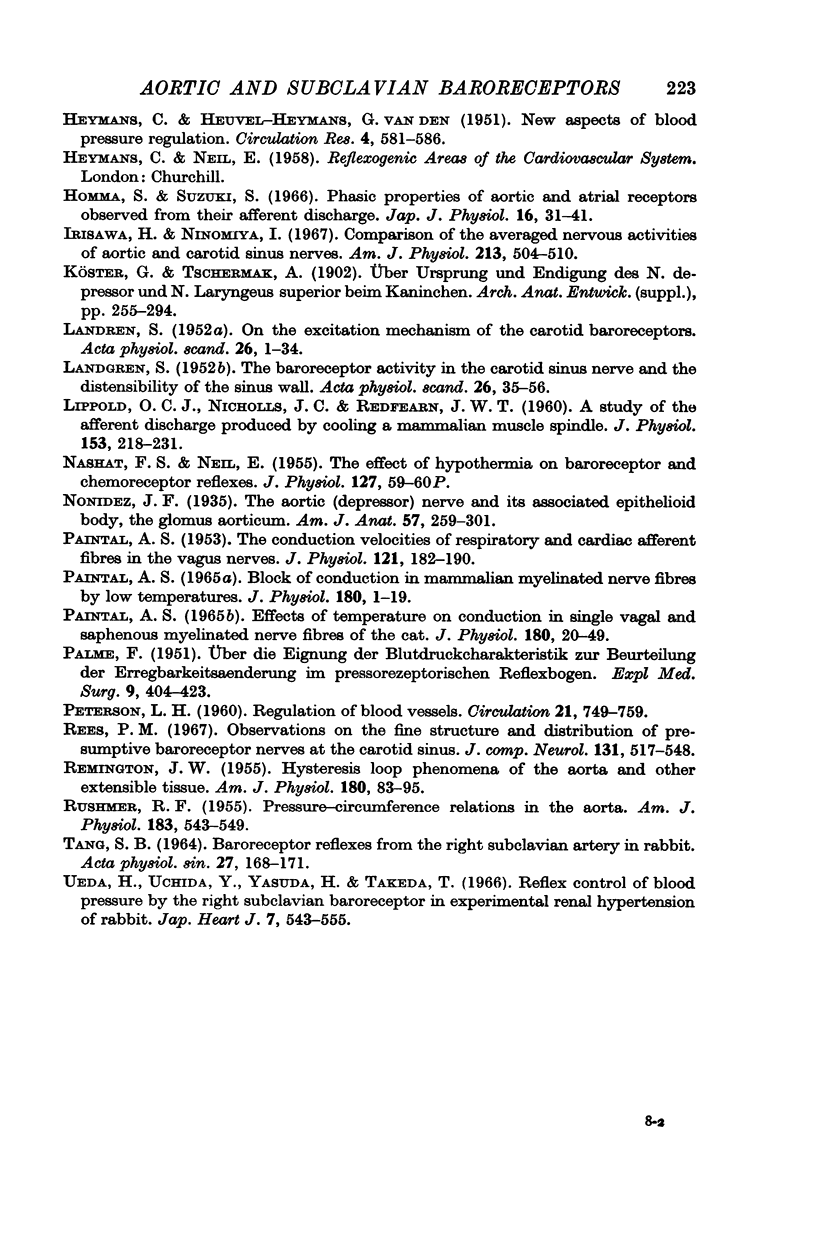
Selected References
These references are in PubMed. This may not be the complete list of references from this article.
- Aars H. Aortic baroreceptor activity in normal and hypertensive rabbits. Acta Physiol Scand. 1968 Mar;72(3):298–309. doi: 10.1111/j.1748-1716.1968.tb03851.x. [DOI] [PubMed] [Google Scholar]
- Aars H. Relationship between aortic diameter and aortic baroreceptor activity in normal and hypertensive rabbits. Acta Physiol Scand. 1969 Mar;75(3):406–414. doi: 10.1111/j.1748-1716.1969.tb04394.x. [DOI] [PubMed] [Google Scholar]
- Adrian E. D. The impulses produced by sensory nerve endings: Part I. J Physiol. 1926 Mar 18;61(1):49–72. doi: 10.1113/jphysiol.1926.sp002273. [DOI] [PMC free article] [PubMed] [Google Scholar]
- Angell James J. E. The effects of altering mean pressure, pulse pressure and pulse frequency on the impulse activity in baroreceptor fibres from the aortic arch and right subclavian artery in the rabbit. J Physiol. 1971 Apr;214(1):65–88. doi: 10.1113/jphysiol.1971.sp009419. [DOI] [PMC free article] [PubMed] [Google Scholar]
- Angell James J. E. The effects of changes of extramural, 'intrathoracic', pressure on aortic arch baroreceptors. J Physiol. 1971 Apr;214(1):89–103. doi: 10.1113/jphysiol.1971.sp009420. [DOI] [PMC free article] [PubMed] [Google Scholar]
- BLOOR C. M. AORTIC BARORECEPTOR THRESHOLD AND SENSITIVITY IN RABBITS AT DIFFERENT AGES. J Physiol. 1964 Nov;174:163–171. doi: 10.1113/jphysiol.1964.sp007479. [DOI] [PMC free article] [PubMed] [Google Scholar]
- BURTON A. C. Relation of structure to function of the tissues of the wall of blood vessels. Physiol Rev. 1954 Oct;34(4):619–642. doi: 10.1152/physrev.1954.34.4.619. [DOI] [PubMed] [Google Scholar]
- Bauer D. J. Vagal reflexes appearing in asphyxia in rabbits at different ages. J Physiol. 1939 Feb 14;95(1):187–202. doi: 10.1113/jphysiol.1939.sp003719. [DOI] [PMC free article] [PubMed] [Google Scholar]
- Bergel D. H. The static elastic properties of the arterial wall. J Physiol. 1961 May;156(3):445–457. doi: 10.1113/jphysiol.1961.sp006686. [DOI] [PMC free article] [PubMed] [Google Scholar]
- Chalmers J. P., Korner P. I., White S. W. The effects of haemorrhage in the unanaesthetized rabbit. J Physiol. 1967 Apr;189(3):367–391. doi: 10.1113/jphysiol.1967.sp008174. [DOI] [PMC free article] [PubMed] [Google Scholar]
- DIAMOND J. Observations on the excitation by acetylcholine and by pressure of sensory receptors in the cat's carotid sinus. J Physiol. 1955 Dec 29;130(3):513–532. doi: 10.1113/jphysiol.1955.sp005424. [DOI] [PMC free article] [PubMed] [Google Scholar]
- HEYMANS C., VAN DEN HEUVEL-HEYMANS G. New aspects of blood pressure regulation. Circulation. 1951 Oct;4(4):581–586. doi: 10.1161/01.cir.4.4.581. [DOI] [PubMed] [Google Scholar]
- Hallock P., Benson I. C. STUDIES ON THE ELASTIC PROPERTIES OF HUMAN ISOLATED AORTA. J Clin Invest. 1937 Jul;16(4):595–602. doi: 10.1172/JCI100886. [DOI] [PMC free article] [PubMed] [Google Scholar]
- Irisawa H., Ninomiya I. Comparison of the averaged nervous activities of aortic and carotid sinus nerves. Am J Physiol. 1967 Aug;213(2):504–510. doi: 10.1152/ajplegacy.1967.213.2.504. [DOI] [PubMed] [Google Scholar]
- James J. E., Daly M. de B. Comparison of the reflex vasomotor responses to separate and combined stimulation of the carotid sinus and aortic arch baroreceptors by pulsatile and non-pulsatile pressures in the dog. J Physiol. 1970 Aug;209(2):257–293. doi: 10.1113/jphysiol.1970.sp009165. [DOI] [PMC free article] [PubMed] [Google Scholar]
- LANDGREN S. On the excitation mechanism of the carotid baroceptors. Acta Physiol Scand. 1952 Jul 17;26(1):1–34. doi: 10.1111/j.1748-1716.1952.tb00889.x. [DOI] [PubMed] [Google Scholar]
- LANDGREN S. The baroceptor activity in the carotid sinus nerve and the distensibility of the sinus wall. Acta Physiol Scand. 1952 Jul 17;26(1):35–56. doi: 10.1111/j.1748-1716.1952.tb00890.x. [DOI] [PubMed] [Google Scholar]
- LIPPOLD O. C., NICHOLLS J. G., REDFEARN J. W. A study of the afferent discharge produced by cooling a mammalian muscle spindle. J Physiol. 1960 Sep;153:218–231. doi: 10.1113/jphysiol.1960.sp006530. [DOI] [PMC free article] [PubMed] [Google Scholar]
- NASHAT F. S., NEIL E. The effect of hypothermia on baroceptor and chemoceptor reflexes. J Physiol. 1955 Mar 28;127(3):59–60P. [PubMed] [Google Scholar]
- PAINTAL A. S. The response of pulmonary and cardiovascular vagal receptors to certain drugs. J Physiol. 1953 Jul;121(1):182–190. doi: 10.1113/jphysiol.1953.sp004939. [DOI] [PMC free article] [PubMed] [Google Scholar]
- PETERSON L. H. Regulation of blood vessels. Circulation. 1960 May;21:749–759. doi: 10.1161/01.cir.21.5.749. [DOI] [PubMed] [Google Scholar]
- Paintal A. S. Block of conduction in mammalian myelinated nerve fibres by low temperatures. J Physiol. 1965 Sep;180(1):1–19. [PMC free article] [PubMed] [Google Scholar]
- Paintal A. S. Effects of temperature on conduction in single vagal and saphenous myelinated nerve fibres of the cat. J Physiol. 1965 Sep;180(1):20–49. [PMC free article] [PubMed] [Google Scholar]
- REMINGTON J. W. Hysteresis loop behavior of the aorta and other extensible tissues. Am J Physiol. 1955 Jan;180(1):83–95. doi: 10.1152/ajplegacy.1954.180.1.83. [DOI] [PubMed] [Google Scholar]
- Rees P. M. Observations on the fine structure and distribution of presumptive baroreceptor nerves at the carotid sinus. J Comp Neurol. 1967 Dec;131(4):517–548. doi: 10.1002/cne.901310409. [DOI] [PubMed] [Google Scholar]
- Ueda H., Uchida Y., Yasuda H., Takeda T. Reflex control of blood pressure by the right subclavian baroreceptor in experimental renal hypertension of rabbit. Jpn Heart J. 1966 Nov;7(6):543–555. doi: 10.1536/ihj.7.543. [DOI] [PubMed] [Google Scholar]


